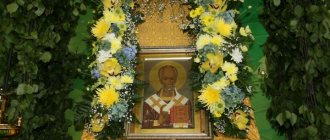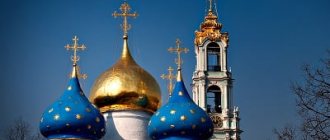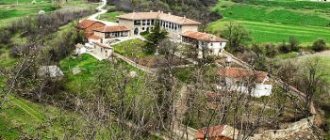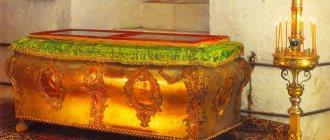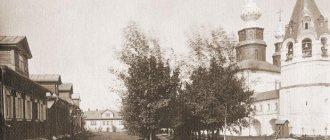| Mch. Nikolai Vunensky. Icon |
Nicholas the New of Thessaly, Tirnavsky, Vunensky
(Greek Νικόλαος ο εν Βουνένοις; + 901/918) [1], martyr [2] Commemoration of May 9 (Greek)
He came from the East and showed deep piety from his youth. He was taken into the army, where he distinguished himself with such courage that Emperor Leo VI the Wise, despite the youth of Nicholas, entrusted him with command of a detachment of a thousand soldiers. The detachment was sent to Thessaly to guard the city of Larissa. Nicholas made sure that his subordinates learned the fear of God to the same extent as the art of war.
At the beginning of the century, enemies invaded Thessaly, took Dimitrias (now Volos), and, exterminating the population and plundering cities and villages, approached Larissa. Realizing that his detachment could not resist, Nikolai ordered the entire population to be withdrawn from the city. He himself, with several warriors, went to the ascetics on a mountain near Tirnava, 16 kilometers northwest of Larissa.
Through fasting and prayer, Nicholas gained peace that no earthly kingdom could bring. One night, while Nicholas and his friends were praying, an angel appeared to them and announced that they must prepare to receive the crown of martyrdom.
A few days later, the conquerors attacked the monastery. Nicholas walked ahead of the Christian soldiers and encouraged them with fiery words, so that at first they prevailed over their enemies, but then they found themselves surrounded. The barbarians captured them and subjected them to cruel torture, demanding that they renounce the Christian faith. The saints remained adamant, as if someone else had suffered for them, and died without renouncing Christ and His Kingdom. Their names were: Ardomy (Armody)
,
Gregory
,
John
,
Demetrius
,
Michael
,
Akindinius
,
Theodore
,
Pancratius
,
Paul
,
Christopher
,
Pantoleon
,
Euodius
and
Emilius (Emilian)
.
Two women, Irina
and
Pelagia
, were also awarded martyrdom.
Only Nikolai managed to escape. Going a little further south, he took refuge on the wooded mountain Vuneni near Karditsa. For some time he led a silent life there in a cave near a large oak tree. Conquering passions and attacks of demons, he shone with the radiance of virtues.
Meanwhile, the barbarians continued to exterminate the people and looked everywhere for the famous commander. Finally they discovered him, suddenly attacked him, grabbed him and tried to force him to renounce Christ by torture. Nicholas replied that he would remain faithful to Him until his last breath. The barbarians mocked him for a long time, and then pierced him through with their own spear.
| Mch. Nikolai Vunensky. Greek icon |
Reverence
After the invaders left, the Bishop of Larisa, together with the surviving population, returned to the city. He transferred the relics of the Tirnava martyrs to Larissa. But the body of Saint Nicholas for the time being remained hidden inside the oak tree and was miraculously preserved from decay and wild animals.
Many years later, around 985, the Thessalian governor Euthymius, being sick with leprosy and having exhausted all medical remedies, turned to the saints for help. He prayed to the Great Martyr Demetrius, and then went to Larissa to the relics of St. Achillius. He had a vision in which he was instructed to bathe in the spring next to the body of St. Nicholas on Mount Vuneni. As a result of a painstaking search, he finally managed to find this place and find the body of the saint. Here the nobleman built a church to place the holy relics in it. After a new revelation, Euthymius found the source. After bathing in it, he was completely healed.
Many churches in Thessaly are dedicated to the martyr Nicholas of Vunensky. Its honorable head now rests in the monastery of St. Nicholas on the island of Andros.
St. Nicholas the New
In the cell of St. Nicholas the Wonderworker, Nicholas the New is especially revered (he is also called Vunensky or Larissky). This Byzantine saint is widely known and loved in modern Greece; thousands of pilgrims come to the place of his death every year, but in Russia not much is known about him yet. That’s why we want to tell you at least briefly about this extraordinary saint and the miracles he performed. St. Nicholas was born in Anatolia, on the Asia Minor peninsula - this is the modern territory of Turkey, but at that time the Byzantine Empire extended there and the entire population was Orthodox. Nicholas was raised in the Christian faith and was a pious young man, but at the same time he was distinguished by strength, wisdom and courage. When he entered military service, Emperor Leo VI the Wise took notice of his abilities, appointed him commander of a thousand and sent him with troops to Larissa, in the Greek province of Thessaly. St. Nicholas prepared his soldiers not only for military combat, but also for spiritual warfare, taught them to stand for the faith and rely on the Lord.
At the beginning of the 10th century, the Arabs again invaded Thessaly, took Dimitrias (now Volos), and, exterminating the population and plundering cities and villages, approached Larissa. The Arabs belonging to the Baghdad Caliphate had already devastated Byzantium for a century, conquered the island of Crete, and Muslim pirates ravaged the eastern Mediterranean. Realizing that his detachment could not resist the superior enemy troops, Nicholas ordered the entire population to be withdrawn from the city. He himself and several warriors went to Vunena. Vunena is a mountain in Thessaly, now called Othrys, near Tirnava, 16 kilometers northwest of Larissa, where a tall forest grew and cells were hidden in dense thickets, in which hermits and virtuous ascetics lived. There the saint labored in the monastery along with his comrades. One night they were praying, and the Angel of the Lord appeared to them and said: “Be ready and stand firm, for in a few days you will suffer martyrdom, in order to receive rewards and crowns of ascetics and inherit the Kingdom of Heaven.”
A few days later, the conquerors attacked the monastery. Nicholas walked ahead of the Christian soldiers and encouraged them with fiery words, so that at first they prevailed over their enemies, but then they found themselves surrounded. The Arabs captured them and subjected them to severe torture, demanding that they renounce the Christian faith. The saints remained adamant, endured all the torments with steadfastness, as if someone else was suffering for them, and died without renouncing Christ and His Kingdom. Their names were: Ardomius (Armodius), Gregory, John, Demetrius, Michael, Akindinius, Theodore, Pancratius, Paul, Christopher, Pantoleon, Euodius and Emilius (Emilian). Two women, Irina and Pelagia, were also awarded martyrdom.
But for St. Nicholas’ hour had not yet come, and this time he was the only one who managed to miraculously escape. Going a little further south, he took refuge on the wooded mountain Vuneni, near Karditsa. For some time he led a silent and holy life there in a cave near a large oak tree, indulging in constant prayer.
Meanwhile, the Arab invaders continued to exterminate the people and looked everywhere for the famous commander. Finally they discovered him, suddenly attacked him, grabbed him and tortured him to force him to renounce Christ and accept their faith. Nicholas replied that he would remain faithful to Him until his last breath. Realizing that they could not shake his firm faith, his enemies decided to put him to a cruel and painful death. So they beat him until the ground turned purple with his holy blood. The scourgers changed two or three times, but the saint held on courageously and valiantly, praying: “I have endured those who have endured the Lord” (Ps. 39). After this, tying him to a tree, the Muslims shot at him with a bow and, taking his spear, threw it at him. The barbarians mocked him for a long time, and then pierced him through with their own spear and cut off his head. This happened on May 9 (May 22 modern style).
After the invaders left, the Bishop of Larisa, together with the surviving population, returned to the city. He transferred the relics of the Tirnava martyrs to Larissa. But the body of Saint Nicholas for the time being remained hidden inside the oak tree and was miraculously preserved from decay and wild animals.
Many years later, around 985, the Thessalian governor Euthymius fell ill with leprosy, one of the most terrible diseases of the Middle Ages. Having exhausted all medical remedies, he turned to the saints for help. He had a vision in which he was instructed to bathe in the spring next to the body of St. Nicholas on Mount Vuneni in the vicinity of Larissa. As a result of a painstaking search in a deep forest, he finally managed to find this place and find the body of the saint, which remained incorrupt and exuded a fragrance. Full of gratitude and joy, the nobleman cleared this place and built a church there, in the middle of which a coffin with the holy relics of the martyr was placed. After a new revelation, Euthymius found the source. After bathing in it, he was completely healed.
In addition to this church on the site of the martyrdom of the saint, many churches in Thessaly are dedicated to Nicholas of Vunensky. His honest head, exuding grace, rests in a silver casket in the monastery of St. Nicholas of Myra on the island of Andros.
In Vounen, at the site of the death of St. Nicholas the New, from the moment his relics were found, miracles began to occur, the likes of which are not found anywhere else on earth, and the fame of which quickly spread throughout Greece. Every year, on his memorial day, May 9 (old style), a dark red liquid similar to blood flows from the huge oak tree where the Arabs killed him, as well as from many trees in the surrounding grove. Chemical analyzes of this liquid made in a scientific laboratory showed an amazing thing: in its composition, the liquid completely corresponds to human blood, but at the same time does not have a blood type. On the day of remembrance of the saint, a prayer service is served in the grove near the sacred oak tree, and a huge number of believers flock to the holiday. People prayerfully collect the blood pouring from the trees into bottles. Monks of the monastery of St. Nicholas of Myra, they also collect blood with trepidation and bring it to the monastery. They distribute this greatest shrine to all those who suffer. Many healings occurred from the holy liquid from the bleeding trees. The saint's blood especially helps with cancer; several stories of miraculous recoveries of patients whom doctors had already abandoned were recorded. Drops of the saint's blood also help with other diseases. Many miraculous appearances of the saint to the sick have also been witnessed.
But the miracles performed by Nicholas the New are not limited to healings. During World War II, when Greece was occupied by the Nazis, the holy warrior Nicholas the New helped his compatriots, taking the enemy away from them.
In recent years, vials with the miraculous blood of Nicholas the New have been brought with pilgrims and monks to Russia, where several healings from incurable diseases have already occurred. Prayer coming from the heart and addressed to a saint also helps. Saint Nicholas the New - a martyr who did not betray his faith, a warrior-defender and a healer from terrible diseases - is becoming more and more revered in Russia.
The life of the saint, prayer service with akathist and his miracles can be read in the books:
“Memory of the Holy Martyr Nicholas the New from Vuneni and those who suffered with him” // Synaxarion. Lives of the Saints of the Orthodox Church. Author-compiler: Hieromonk Macarius of Simonopetra. Adapted translation from French. In 6 vols. - M.: Sretensky Monastery Publishing House, 2011, vol. V, p. 127-130.
“Nicholas the New, who labored in Vuneny.” M. Publishing house of the Sretensky Monastery. 2005.
Used materials
- “Memory of the Holy Martyr Nicholas the New from Vuneni and those who suffered with him” // Synaxarion. Lives of the Saints of the Orthodox Church. Author-compiler: Hieromonk Macarius of Simonopetra. Adapted translation from French. In 6 vols. - M.: Sretensky Monastery Publishing House, 2011, vol. V, p. 127-130.
[1] The most common dating now is tied to the invasions of the beginning of the century - the Arabs (April 901) or the Bulgarians under the leadership of Tsar Simeon (918). Other assumptions have been put forward - the oldest surviving life of the saint, which is very different from the established Greek version, dates his life back centuries. See BHG 2308. Also his martyrdom was associated with the Avarian invasion and was dated to 700. See the calendar on the Pravoslavie.Ru
, ; Menea. May, part 1, ed. Moscow Patriarchate, p. 487: .
[2] In some sources he is called the Venerable Martyr.
How does Saint Nicholas help?
Who needs to buy an icon of St. Nicholas the Wonderworker? What does the saint help with and who should pray to him especially fervently?
- To all Nicholas, baptized in honor of this saint, this is their heavenly patron.
- Sailors.
- Travelers (especially by sea).
- Entrepreneurs, businessmen.
- Children and their parents.
- To girls praying for a happy and prosperous marriage.
The saint is the patron saint of sailors and travelers due to a miraculous event that occurred during his earthly life. One day, while traveling on a ship, the saint predicted an approaching storm. And so it happened. However, through the prayers of St. Nicholas, the storm subsided. Therefore, even today, when setting out on a journey or already on a trip, it is necessary to pray to the miracle worker. He will protect you - rest assured.
Also, as legend says, Nikolai Ugodnik once saved a merchant from the fall. The man began to have serious problems in his business, which led to financial difficulties. To rectify the situation, the merchant wanted to give his three daughters to commit fornication. Saint Nicholas could not allow this to happen. Late at night, the righteous man threw bags of gold into the merchant’s windows. Now there was no need for the merchant to send the girls to sin. Therefore, if you are engaged in business, do not forget to pray to the saint. It is advisable to do this in front of the icon of St. Nicholas the Wonderworker. Thousands of businessmen have become convinced of how the saint helps.
In addition, the saint is the patron saint of children. That is why he became the prototype of Santa Claus, Father Frost and other New Year's characters in different countries. You can pray to Saint Nicholas for the health of children, for their admonition (both children and adults), for the protection of children from criminals and more. Parents, grandparents, teachers and almost all people who have affection for a particular child can pray for children.
Of course, if you do not belong to the above categories of people, you can also pray to St. Nicholas the Pleasant. A prayer offered with sincere faith will certainly be heard.
Did Saint Nicholas hit Arius on the cheek?
The Greek Damascene Studite, Metropolitan of Nafpaktos and Arta (XVI century) in his book “Treasure” sets out the legend that during the Ecumenical Council Nicholas “hit on the cheek” his opponent Arius.
This is refuted by the professor of church history V.V. Bolotov: “Not one of the legends about the Council of Nicaea, even with a weak claim to antiquity, mentions the name of Nicholas, Bishop of Myra, among its participants.”
The very facts of the strangulation of Arius by Nicholas and the trial of Nicholas are entirely absent in the life of Nicholas, written by Simeon Metaphrastus in the 10th century and placed in the Chetii-Minea, there is nothing of the kind in the life of Nicholas, placed in the Greek Synaxar, these events are not present in the Great Chetya -Minaiah, collected and published by Saint Macarius in the middle of the 16th century. A description of a slap in the face first appears in Russian hagiography only at the end of the 17th century in the Lives of the Saints, written by Metropolitan Dimitri of Rostov.
The death and relics of St. Nicholas the Wonderworker
The saint reposed in 345 in Myra in Lycia. After his death, the saint’s body began to exude myrrh—fragrant oil. First a basilica and then a temple were built over his grave. In 1087 the relics of St. Nicholas the Wonderworker were kidnapped by the Italians and transported to the Italian city of Bari, where they remain to this day. Crowds of pilgrims flock to the myrrh-streaming relics of the saint every day, where many receive healing.
Memorial Day of St. Nicholas the Wonderworker:
- The day of death is December 19.
- The day of transfer of relics is May 22.
- The saint's birthday is August 11.
Is it true that icons almost accurately convey the appearance of the saint?
Anthropological studies have confirmed that the icons quite accurately convey the appearance of St. Nicholas.
In 1953, during restoration work in the church in which the crypt is located, Luigi Martino, an anatomist from the University of Bari (Universita degli Studi di Bari), with the permission of the Vatican, examined the bones, leaving behind many x-rays and detailed measurements.
He also made a conclusion about the saint’s illnesses. Damaged joints, spine and chest bones testify to the torment that St. Nicholas suffered in prison - he was tortured on the rack. Radiological examination of the skull showed extensive internal bony compaction of the skull.
Professor Martino believes that these changes are caused by the long-term influence of prison cold and dampness (the saint spent about twenty years in prison).
According to eyewitnesses, his face was filled with holiness and grace. They say that an amazing radiance emanated from him, like from the prophet of God Moses. That is, grace was obviously inherent in him. Luigi Martino reconstructed the appearance of St. Nicholas from the skull.
This allowed Martino's contemporary colleagues to carry out the reconstruction. It was made of “virtual” clay, the shape of which can be changed directly on the screen. Saint Nicholas had a masculine face with olive skin, a square chin and a broken nose. This was determined by the severely damaged bones between the eyes.
